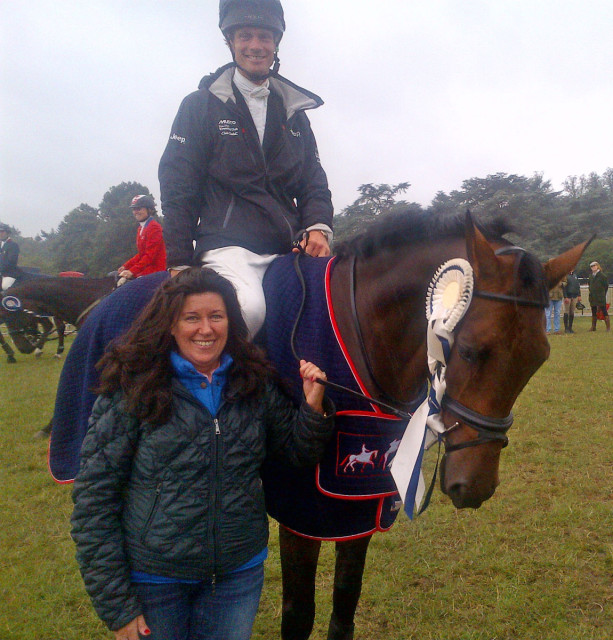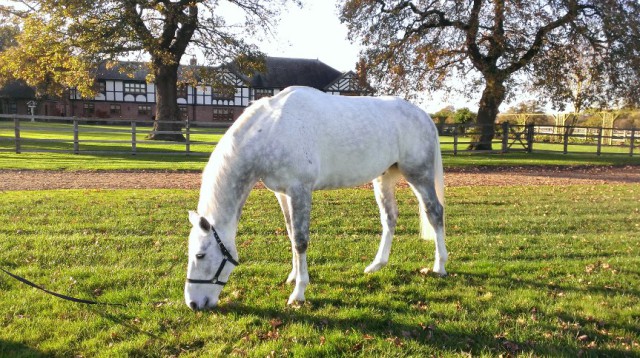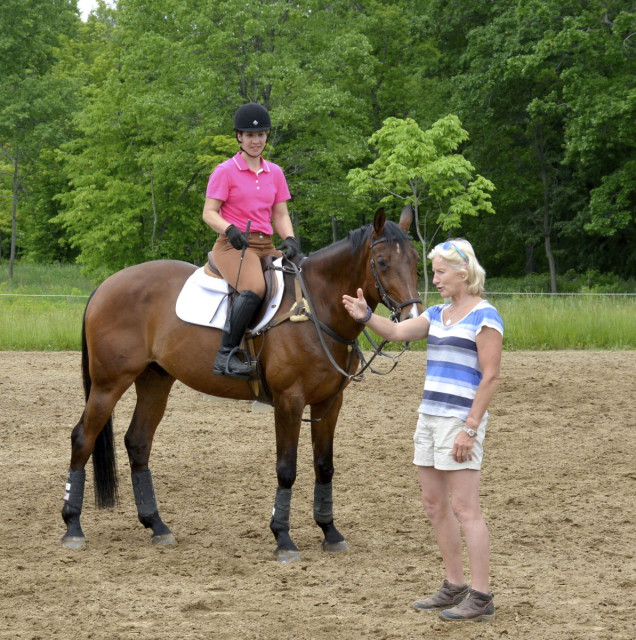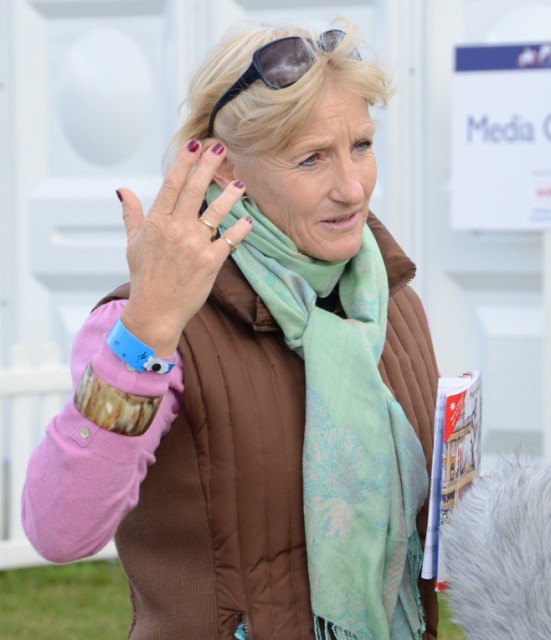
Catherine Witt, William Fox-Pitt and Fernhill Pimms at Blenheim 2013. Photo courtesy of Catherine Witt/Rookery Park.
What do a secret agent, Billy Elliot, Scooby Doo and Danger Mouse all have in common? Read on to find out!
Being a horse lover — as is everyone who reads EN — I continue to marvel at the skill and discipline of the upper-level event horses. But in addition to that, I wonder about the personalities of the horses when they don’t have on their game face.
So who better to ask about the behind-the-scenes personalities of top level event horses than Catherine Witt, who happens to own several upper-level event horses: several as in eight three-star or four-star horses (and nine if you count the one just retired)!
Catherine, who lives in the UK, has horses with the likes of William Fox-Pitt, Francis Whittington and Bill Levett. The names of her horses are quite familiar to all of us, having won 12 FEI competitions in the last few years, including Rolex and Blenheim in 2014.
Here we go through the list of names: Bay My Hero, Fernhill Pimms, Luxury FH, Parklane Hawk, Seacookie TSF, The Soapdodger, Alexander NJ, Easy Target and Fernhill Highlight. Wow!
Catherine had been involved with race horses for many years, but was fearful of racing accidents with so many horses all running at once. A keen horsewoman herself, she happened to see William Fox-Pitt riding at a local event.
Well, it seems a dream was born that day, as Catherine decided that she would love to have a three-day event horse ridden by William, and she also felt that there would be less chance of horse injury in a pile up since there are only one or two horses on course at a time. So from a chance glimpse of William’s masterful riding, a full-time avocation was born!
Rookery Park in Nantwich, Cheshire, is home base for Catherine, and many of her horses spend their early years or their “vacations” at Rookery. Rookery, a 30-stall, 200-acre stable, is also where some of the young horses show their stuff and give a glimpse of what they might like to do in the future.

Catherine Witt and Luxury FH. Photo courtesy of Catherine Witt/Rookery Park.
Luxury FH
Take Luxury FH, for example, who will be stepping up to the three-star level this year after placing second at the Tattersalls CCI2* and Osberton CCI2* in 2014, as well as winning the Smith and Williamson British Intermediate Championship at Gatcombe this year with rider William Fox-Pitt.
Catherine describes Luxury FH as a “Scooby Doo personality,” since it takes a nanosecond for cues to kick in, and then he has that “yup, yup, let’s go” attitude.
After putting in his winning round at Gatcombe, William said that Luxury went into the ring, where the stands are very close, and “it felt like he spoke to every person in the stadium. I couldn’t believe he left all the poles up!” Catherine said that William was “astounded” that he never touched a rail since this fellow likes to introduce himself to everyone.

Minty on vacation at Rookery Park. Not a “soapdodger” in this picture! Photo courtesy of Catherine Witt/Rookery Park.
The Soapdodger
Two other of her lesser known (at least in the U.S.) horses ridden by WFP are The Soapdodger and Fernhill Pimms. Anyone want to wager on which name William doesn’t care for? You would be correct if you picked The Soapdodger; in fact, Catherine stated that William was “appalled” that she used that particular British colloquialism to describe this lovely grey gelding.
“Minty,” as he is known around the barn, is a typical hard-to-keep-clean 7-year-old with a bright future, having joined William’s string in April 2014 and finishing the season with a second place at the Osberton CICYH*. The Soapdodger is a crowd-pleaser, as many people have commented that they love his name, which William has accused Catherine of rigging up.
Catherine has high hopes for this young man, though, and has reminded William that he will learn to love the name, especially if he hears it being announced at Burghley in a few years! (Editor’s Note: “Soapdodger” is a British term describing an unkempt or dirty individual — definitely a clever name for a light grey horse. We like it, Catherine!)
Fernhill Pimms
Fernhill Pimms is another of Catherine’s horses and one that is co-owned by Carol Gee. “Pimms,” of course, is named after that famous brew, and he won the Blenheim Palace International Horse Trials CIC3* for 8- and 9-year-olds in 2013 with William in the irons.
Pimms is one who feeds on the atmosphere, and once he sees all the hoopla and the flags flying, he will snap to attention, Catherine says, as if he is saying, “Colorful flags, lots of people: This must be important!”

A beautiful Moonie in a picture perfect pose at Lexington. Catherine did say he thinks everyone is there to see him! Photo courtesy of Catherine Witt/Rookery Park.
Bay My Hero
While the youngsters are learning the ropes, Catherine and William still have the heavy hitters to plan for. The superstar Bay My Hero, or “Moonie,” has been with Catherine since 2007. As for the story of how the name Moonie came about, it harkens back to his sire Cult Hero and how some cults worship the moon — hence Moonie, get it?
Moonie, in addition to winning the Rolex Kentucky CCI4* in the spring of 2014, was also fourth at the Burghley CCI4* last fall. Catherine describes Moonie as a “Billy Elliot type of horse — always dancing around and very happy in his own skin.” Moonie is quite the confident guy and thinks that anyone around him is there just to see him.
Following the Burghley 2014 competition, it was found that Moonie had been brewing a chest infection, which William felt contributed to him being “a little under par but still game for the cross country.” Like so many four-star horses, Moonie loves his job and is a trier.
His favorite treats are mints, which Catherine generously supplies to all the boys. Moonie takes it to an extreme, though, so much so that during Moonie’s younger years, William banned Catherine from the dressage warm-up ring, since Moonie would immediately focus on Catherine and her pockets as soon as he saw her or heard her voice.
Nowadays he is much more disciplined but still loves to be in the thick of things, especially if there is trouble going on in the pasture. We could be seeing Moonie again this year at Rolex, but that is not a firm decision at this point.
Parklane Hawk
Another possible entry at Rolex is Parklane Hawk or “Parker,” a barn name easy to figure out. Parker had a slower year in 2014 after four years of incredible work winning the Blenheim CCI3* in 2010, the Burghley CCI4* in 2011 and the Rolex CCI4* in 2012; placing third at Burghley in 2012; and coming fifth at the Badminton CCI4* and third at Burghley in 2013. (Note to self: It will never happen to you, so don’t even dream about it!)
An import from New Zealand, Catherine describes Parker as being “very workmanlike and not having the personality of the others, but being like a Lamborghini — very efficient and precise. He has a good work ethic and does his job with quality and skill.” However, Parker is 15, and that is when Catherine likes to see the horses step down from the limelight, so he may be retiring soon.

Seacookie in retirement. Photo courtesy of Catherine Witt/Rookery Park.
Seacookie TSF
One stalwart of the stable is Seacookie TSF, a Trakehner gelding that Catherine has owned since 2008 and has now retired. Seacookie had an illustrious career, having placed second at Burghley in 2010, first at Blenheim CCI3* in 2012, second at Lexington in 2013, first at Pau in 2013 and ninth at Rolex in 2014.
Catherine believes in retiring her horses in one piece and at the age of 15. Retirement for Catherine’s horses means spending the rest of their lives at Rookery Park, enjoying their leisure years as a pasture puff or carrying on their careers in a less demanding endeavor “until they leave this planet,” as she puts it.
Giving back to her horses is a priority even before retirement, and they will frequently spend their down time “on holiday” after a big competition season at Rookery Park. We all need a holiday at Rookery, which has a beautiful Tudor-style barn.
Easy Target
A recent feature on EN was another of Catherine’s horses, Easy Target or “Smokey.” This grey gelding is ridden by Francis Whittington; he had a great season in 2014, albeit that Badminton didn’t end the way it started out since Francis had to retire on cross country after a spectacular dressage test.
However, Smokey did go on to place second in both the CIC3* competitions at Barbury Castle and Gatcombe Park and then upped the ante by winning the Blenheim CCI3* in September. And the great news for us in the U.S. is that we could be seeing Smokey in Kentucky this year.
Francis describes Smokey as a horse with a lot of heart, and Catherine compares him to “Danger Mouse” since he has so much will. She describes him as maybe “not the best galloping horse,” but one that loves to get into everything and frequently has only two feet — the back ones — on the ground. You can read the report on Francis’ clinic that was recently held in North Carolina by clicking here.
Fernhill Highlight
Last but not least of Catherine’s upper-level horses is another one with that famous Fernhill prefix — Fernhill Highlight. “Fernie” started his one- and two-star career with William before getting a little homesick, and he returned to Rookery, where Catherine was able to create a long-term partnership with Francis.
Catherine describes Fernhill Highlight as being like a “secret agent — his persona is on the quiet side, and he likes to stay under the radar.” He placed fifth at Blenheim in 2014, a few places behind his stablemate Freddie Mac, after dropping a rail in stadium and will hopefully be moving up to the four-star level in 2015.
Alexander NJ
A third rider to whom Catherine entrusts her horses is Bill Levett, who is campaigning Alexander NJ at the two- and three-star level. Catherine is one-third owner in this horse and enjoys supporting a variety of riders. “It all helps the sport to grow, as riders have to have good horses to attract owners.” This 10-year-old gelding has been in the top 10 during 2014, placing at both the Tattersalls CCI3* and the Burnham Market CIC3*.
Catherine sees herself as being incredibly lucky but is also realistic and says that she doesn’t expect her luck to go on forever. “I know there will be a time when I start to fade away from eventing, so every success is precious. I have been more fortunate than others, but the circles of owners that I have come to know are all very supportive of each other,” she said.
“I am always cheering for the winner, and I say to myself, ‘Well, it wasn’t me this time, but good for him or her!’ Being able to participate in this sport is a dream come true.”
For Catherine, the upper-level competitions are also a trial to get through, and she says that the only day she is not anxious is the day before the trot up, and by the end of the competition, she has a migraine headache. Catherine also has a policy of not getting involved with the rider during the competition and lets the riders come to find her when they have the time, usually in the evening of each day.
“I try to keep a low profile,” she said. But she also makes sure the grooms are well cared for and sponsors a dinner for the British, New Zealand and Australian grooms on the final day of the competition. “I don’t attend. I am usually in my hotel room having a migraine!” she said. “But if my horses never win another thing, I’ve been very fortunate.”
Catherine has been looking for another horse to continue her involvement in the sport, and she said that horses “sort of come to me. But I only have geldings and no chestnuts at all!”
I did tell her that if I wrote on EN that she is looking for a new horse she would be besieged once she arrives in Kentucky this year! Her reply was “isn’t that the best way?” So anyone out there with an upper-level potential horse that is a gelding and not a chestnut, you may want to seek her out in April!
Good luck to Catherine and all her horses this coming year, and Go Eventing!



















































